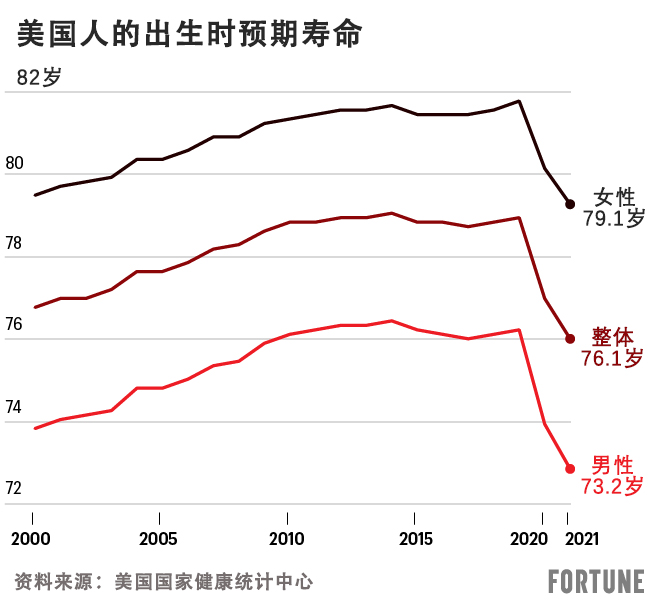美國(guó)人的預(yù)期壽命降至自1996年以來的最低水平,,主要原因是新冠疫情造成100多萬人死亡的影響。
今年8月31日發(fā)布的一份聯(lián)邦政府報(bào)告顯示,,去年美國(guó)人的平均壽命為76.1歲,,2020年為77歲。在2019年新冠疫情爆發(fā)之前,,美國(guó)人的平均壽命為78.8歲,,比去年高出2.7歲,。
美國(guó)疾病控制與預(yù)防中心(Centers for Disease Control and Prevention)下屬的美國(guó)國(guó)家健康統(tǒng)計(jì)中心(National Center for Health Statistics)的研究人員寫道:“新冠疫情是導(dǎo)致全人口預(yù)期壽命出現(xiàn)負(fù)面變化的主要原因?!?/p>
死因別死亡率(cause-specific death rates)升高導(dǎo)致預(yù)期壽命下降,,其中有50%來自新冠疫情。
意外傷害,、心臟病,、慢性肝病和自殺也是導(dǎo)致死亡率上升的影響因素。例如,,意外傷害的占比約為16%,,心臟病的比例提高了4.1%。而肝病在其中占3%,,自殺占2.1%,。
在新冠疫情之前,美國(guó)的預(yù)期壽命總體持續(xù)提高,,2014年達(dá)到最高峰,,平均預(yù)期壽命接近79歲。之后,,隨著阿片類藥物導(dǎo)致的死亡人數(shù)大幅增加,,美國(guó)人的預(yù)期壽命開始緩慢下降。
報(bào)告在估算預(yù)期壽命時(shí),,使用了2021年的臨時(shí)死亡率數(shù)據(jù)以及2019年和2020年的最終數(shù)據(jù),。
男性和女性的預(yù)期壽命均有所下降,但女性依舊更長(zhǎng)壽,。男性的預(yù)期壽命為73.2歲,,而2020年為74.2歲,2019年新冠疫情之前為76.3歲,。女性的預(yù)期壽命下降至79.1歲,,2020年為79.9歲,,2019年為81.4歲,。

報(bào)告稱,2021年,,預(yù)期壽命的性別差異擴(kuò)大,,目前男女預(yù)期壽命相差約6歲。
在種族和民族方面,,美洲原住民去年的預(yù)期壽命下降幅度最大,,下降1.9歲至65.2歲,而在2020年為67.1歲,。從2019年到2021年,,美洲原住民的預(yù)期壽命總體下降了6.6歲,,為所有種族群體同期內(nèi)的最大降幅。
與此同時(shí),,亞裔壽命下降幅度最小,,去年僅下降了0.1歲,平均預(yù)期壽命為83.5歲,,2020年為83.6歲,。從2019年到2021年,亞裔預(yù)期壽命從2019年的85.6歲下降至83.5歲,,下降2.1歲,。
預(yù)期壽命下降可能產(chǎn)生重大影響。
美國(guó)國(guó)家健康統(tǒng)計(jì)中心的死亡率統(tǒng)計(jì)主管羅伯特·安德森告訴《紐約時(shí)報(bào)》(New York Times):“即使預(yù)期壽命小幅下降十分之一或十分之二歲,,從總體來看意味著有更多人過早死亡,。”
他補(bǔ)充說:“這意味著死亡率上升對(duì)人口產(chǎn)生了巨大影響,?!保ㄘ?cái)富中文網(wǎng))
譯者:劉進(jìn)龍
審校:汪皓
美國(guó)人的預(yù)期壽命降至自1996年以來的最低水平,主要原因是新冠疫情造成100多萬人死亡的影響,。
今年8月31日發(fā)布的一份聯(lián)邦政府報(bào)告顯示,,去年美國(guó)人的平均壽命為76.1歲,2020年為77歲,。在2019年新冠疫情爆發(fā)之前,,美國(guó)人的平均壽命為78.8歲,比去年高出2.7歲,。
美國(guó)疾病控制與預(yù)防中心(Centers for Disease Control and Prevention)下屬的美國(guó)國(guó)家健康統(tǒng)計(jì)中心(National Center for Health Statistics)的研究人員寫道:“新冠疫情是導(dǎo)致全人口預(yù)期壽命出現(xiàn)負(fù)面變化的主要原因,。”
死因別死亡率(cause-specific death rates)升高導(dǎo)致預(yù)期壽命下降,,其中有50%來自新冠疫情,。
意外傷害、心臟病,、慢性肝病和自殺也是導(dǎo)致死亡率上升的影響因素,。例如,意外傷害的占比約為16%,,心臟病的比例提高了4.1%,。而肝病在其中占3%,自殺占2.1%,。
在新冠疫情之前,,美國(guó)的預(yù)期壽命總體持續(xù)提高,2014年達(dá)到最高峰,平均預(yù)期壽命接近79歲,。之后,,隨著阿片類藥物導(dǎo)致的死亡人數(shù)大幅增加,美國(guó)人的預(yù)期壽命開始緩慢下降,。
報(bào)告在估算預(yù)期壽命時(shí),,使用了2021年的臨時(shí)死亡率數(shù)據(jù)以及2019年和2020年的最終數(shù)據(jù)。
男性和女性的預(yù)期壽命均有所下降,,但女性依舊更長(zhǎng)壽,。男性的預(yù)期壽命為73.2歲,而2020年為74.2歲,,2019年新冠疫情之前為76.3歲,。女性的預(yù)期壽命下降至79.1歲,2020年為79.9歲,,2019年為81.4歲,。
報(bào)告稱,2021年,,預(yù)期壽命的性別差異擴(kuò)大,,目前男女預(yù)期壽命相差約6歲。
在種族和民族方面,,美洲原住民去年的預(yù)期壽命下降幅度最大,,下降1.9歲至65.2歲,而在2020年為67.1歲,。從2019年到2021年,,美洲原住民的預(yù)期壽命總體下降了6.6歲,為所有種族群體同期內(nèi)的最大降幅,。
與此同時(shí),,亞裔壽命下降幅度最小,去年僅下降了0.1歲,,平均預(yù)期壽命為83.5歲,,2020年為83.6歲。從2019年到2021年,,亞裔預(yù)期壽命從2019年的85.6歲下降至83.5歲,,下降2.1歲。
預(yù)期壽命下降可能產(chǎn)生重大影響,。
美國(guó)國(guó)家健康統(tǒng)計(jì)中心的死亡率統(tǒng)計(jì)主管羅伯特·安德森告訴《紐約時(shí)報(bào)》(New York Times):“即使預(yù)期壽命小幅下降十分之一或十分之二歲,,從總體來看意味著有更多人過早死亡?!?/p>
他補(bǔ)充說:“這意味著死亡率上升對(duì)人口產(chǎn)生了巨大影響。”(財(cái)富中文網(wǎng))
譯者:劉進(jìn)龍
審校:汪皓
Life expectancy in the U.S. has plunged to its lowest since 1996, mostly due to the impact of more than 1 million deaths from COVID.
The average life-span last year was 76.1 versus 77 in 2020, according to a federal government report released on August 31. Before the COVID pandemic, in 2019, Americans lived an average of 78.8 years, or a full 2.7 years longer.
“COVID-19 was the leading cause contributing negatively to the change in life expectancy for the total population,” wrote researchers from the National Center for Health Statistics, a division of the Centers for Disease Control and Prevention.
COVID accounted for 50% of the increases in “cause-specific” death rates, which contributed to the plunging life expectancy.
Unintentional injuries, heart disease, chronic liver disease, and suicide also played a role in the increases in mortality. For example, unintentional injuries accounted for nearly 16% while heart disease added 4.1%. Meanwhile, liver disease was responsible for 3% and suicide for 2.1%.
Before the pandemic, U.S. life expectancy had generally been rising until it peaked in 2014 with at an average of nearly 79 years. At that point, it slowly declined as opioid deaths soared.
To provide life expectancy estimates, the report used provisional mortality data for 2021 and final data for 2019 and 2020.
Life expectancy declined for both men and women, but women’s life expectancy is still longer. For men, life expectancy was 73.2 years, down from 74.2 in 2020 and 76.3 in pre-pandemic 2019. For women, life expectancy declined to 79.1 years, versus 79.9 years in 2020 and 81.4 in 2019.
The difference in life expectancy between sexes, the report said, increased in 2021 and is now nearly six years.
In terms of racial and ethnic groups, Native Americans had the biggest drop in life expectancy last year— 1.9 years—to 65.2 versus 67.1 in 2020. That marks a total decline of 6.6 years from 2019 to 2021—the largest of all race-based groups over that period.
Meanwhile, the Asian population had the smallest decline—a drop of 0.1 years— to 83.5 years last year versus 83.6 in 2020. From 2019 to 2021, the decline was 2.1 years to 83.5 versus 85.6 in 2019.
The impact of this decline in life expectancy can be substantial.
“Even small declines in life expectancy of a tenth or two-tenths of a year mean that on a population level, a lot more people are dying prematurely than they really should be,” Robert Anderson, chief of mortality statistics at the NCHS, told the New York Times.
He added: “This signals a huge impact on the population in terms of increased mortality.”






